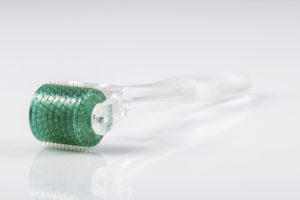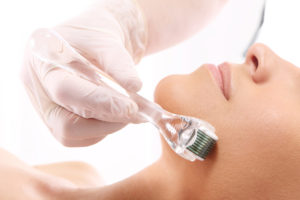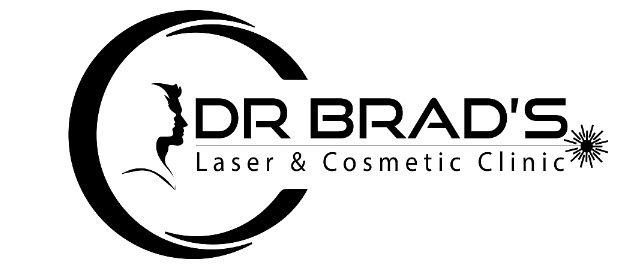If you are interested in dermalroller skin microneedling then you're in the right place. Dr Brad is an expert in microneedling and it can be used to treat a diverse range of common conditions. Visit him at his clinic for a consultation and treatment.
Watch this video of Dr Brad demonstrating a dermaroller treatment:
What is Dermaroller?
Dermaroller® is the brand name of just one microneedling roller device. Other companies such as Boston Medical and Medik8 (SkinRolla®) and a few others manufacture near identical products.

A typical dermal roller microneedling device.
What Is Microneedling And How Does It Work?
Microneedling treatment is the application to the skin of a specialised instrument (a roller or a stamp) covered in microneedles. This is performed with the intention of creating hundreds or thousands of micropunctures in the skin.
When the skin experiences trauma, such as a laceration, it causes the release of growth factors that promote the production of new collagen, elastin and blood supply in the dermis.
Micropuncture treatment deliberately creates hundreds or thousands of micropuncture traumas, so that the skin is stimulated to produce new collagen, elastin and blood supply throughout the treated area. This results in skin that has more volume, elasticity and a more healthy, youthful overall appearance.
It is a “non-ablative treatment” meaning that it does not remove the epidermis (outer layer of skin).
Furthermore, microneedling also increases the permeability of the skin to enhance the absorption of skin care products or chemical peel agents.
Microneedling can either be performed using a roller device or a stamp device. These are called “dermal rollers” and “dermal stamps” respectively.
Microneedling is the low-tech equivalent of a fractional laser resurfacing treatment but can still be effective in its own right.
What Is Microneedling Used To Treat?
Microneedling treatment is used to treat a variety of common skin conditions including general ageing, loss of elasticity and volume, wrinkling, acne scarring, chicken pox scarring, other scarring, pigmentation problems (melasma, lentigines or “sun spots”).

A dermal roller about to be applied to the forehead.
Common areas treated include the face, neck, décolletage (upper chest), backs of the hands, abdominal stretch marks (striae gravidarum) and even thigh cellulite. Almost any area of the body can be treated.
People with any racial skin type can receive microneedling therapy.
How Is Microneedling Performed?
Microneedling is performed with either a roller device or a stamp device.
The stamp is used to treat small problem areas of skin approx. 1-2cm diameter whilst a roller device is used to treat larger areas of skin ie the forehead.
Each area should be treated with 5-10 passes of the device in each direction in a “Union Jack” pattern.
The clinician is aiming for a uniform distribution of bleeding points over all of the treated skin at the end of treatment.
A needle length of 1.5mm is generally good for the face, neck, decolletage and backs of hands.

The dermal roller device is rolled briskly over all areas of the face, forehead, cheeks, chin and upper white lip.
A 3mm needle length is typically more effective for other areas of the body, particularly with respect to stretch marks and cellulite.
What Is The Aftercare Advice Following A Microneedling Session?
Once the doctor has completed the microneedling treatment and applied the relevant products, the patient should not wash their face for 8-12 hours and should not use make up on for 24 hours.
How Often Is Microneedling Performed?
Microneedling is usually performed over 3 sessions. The intervals between those three sessions is often 6 weeks but may be reduced to 3-4 weeks if the patient and clinician agree, depending on goals and individual recovery times.
Do Any Products Need To Be Used Before And During Microneedling?
Products including Vitamin A and C, plus any other treatments for more specific skin problems, perhaps with a Vit E based moisturiser should all ideally be used for at least 2 weeks before treatment, between treatments and for at least weeks post-treatment for optimal results.
Can Microneedling Be Combined With Other Treatments?
Yes. Microneedling can be combined effectively with other treatments such as dermal fillers, toxinjectables and even chemical peels. In fact, the shallow application of a microneedling to the skin just before a peel can enhance the beneficial effects of the peel.
Is Microneedling Safe?
When used in accordance with established manufacturer instructions and industry guidelines and under the guidance and supervision of a qualified doctor microneedling is both a safe and effective treatment.
Does Microneedling Hurt?
Microneedling Is surprisingly tolerable with needle lengths up to 0.2mm but some people can tolerate 0.5mm needles too. Any needling treatment over 0.5mm should really be performed after the application of topical anaesthetic for the comfort of the patient. Typical topical anaesthetic creams in common usage such as Emla and Ametop contain lidocaine and when these are used the technique is largely painless.
Do People Bleed More On Subsequent Microneedling Treatments.
It is not uncommon for bleeding points to occur more easily on second and subsequent microneedling treatments. This is often attributable to the new and improved blood supply to the skin so is simply a sign of an effective treatment. It is not harmful.
Can I Do Microneedling At Home With A Personal Roller?
Home dermal roller treatment can be used as part of a self-care skin routine. Most people using the treatment at home on themselves will use a roller with needles no longer than 0.2mm or 0.3mm for ease and comfort of application. The shorter needles obviously don’t penetrate as deeply as longer needles. However, the penetration of skin care products is sufficiently enhance by shorter needles. Longer needles don’t enhance beneficial penetration very much better than short needles but they do induce collagen and elastin production more effectively.
The shorter depth of penetration carries less risk of infection than longer needles so disinfection of the treatment area before treatment is not required. Washing the skin with a cleanser beforehand should suffice.
Sanitisation instructions for care of the needles is included in the pack. A roller can last 3-6 months, depending on usage and should be disposed of responsibly according to product instructions.
The presence of a microneedling device in a household represent a “sharps risk” and “needlestick hazard” for other household users so safe storage of the product is essential and the sole responsibility of the owner.
How Often Should Skin Microneedling Be Performed?
Home skin microneedling treatments should be performed no more than once a day and 3 times a week to reduce the risk of side effects whilst still deriving some benefit.
What Is A Dermastamp Used For?
Dermastamp or “microneedle stamp” treatment works in exactly the same way as the roller treatment but is used for smaller, more specific problem areas.
What Are The Contraindications For Microneedling?
Certain conditions are incompatible with safe microneedling. These include but are not necessarily limited to scleroderma, collagen diseases, rosacea, blood clotting problems, anticoagulants, oral steroids, cancer, active infection, immunosuppressive medications or diseases, uncontrolled diabetes, pregnancy, viral warts, uncontrolled eczema, skin cancers or solar keratosis, breast feeding, severe mental illness, scars less than 6 months old, facial surgery in the past 6 months, keloid scarring, psoriasis, vitiligo.
Patients with a history of “cold sores” (AKA herpes labialis) should take a one week prophylactic course of aciclovir from 48 hours before their treatment to reduce the risk of an exacerbation.
“Moles” should not be microneedled but should simply be avoided during a treatment.
What Are The Risks And Side-Effects Of Microneedling?
The risks are those that come any time a needle penetrates the skin: infection, bleeding, bruising. Wreckless or incorrect use of a dermal roller can result in skin tearing. Overuse of microneedling can cause scarring.
The treated skin may be somewhat inflamed for 24-48 hours after the treatment.
It is worth mentioning that there is hardly any risk of post-inflammatory hyperpigmentation or UV sensitisation with microneedling.
What Does Dermal Roller Microneedling Cost?
All micro-needling treatments benefit from the regular use of “high-end” priming and recovery skincare cosmeceutical products between treatments for optimal results. Patients can obtain these from Dr Brad at exclusive low prices (often under £99 for a full bundle).
Dermal Roller (1.5mm titanium needles)
- Ideal for ageing/aged skin or deeper acne scarring.
Face or Hands: One session £240; Recommended course of three sessions £600
Neck and Decolletage together: One session £260; Recommended course of three sessions £660
Dermal Roller (3mm titanium needles)
- Ideal for cellulite or stretch marks.
One body area: One session £270; Course of three sessions £640
Special Carboxytherapy Upgrade Offer For Microneedling Treatments.
Emerge laser patients qualify for 10% off any carboxytherapy treatment package. Carboxytherapy can be delivered immediately after your laser treatment and once or twice a week thereafter for an enhanced experience.
Summary
Microneedling, alone or in combination with other relevant treatments, is a safe and effective treatment for a variety of common skin problems.
Doctor Brad is a Dermalroller microneedling expert using medical grade equipment that simply isn't available to the general public so call (07588971425) or email today for an initial consultation and superior treatment.
